
Sikkim
Places of Interest, Gangtok, Institute of Tibetology, Rumtek Monastery,
Tsomgo Lake, Nathula, Pemayangtse Monastery, Kheocheopalri Lake,
Yuksom, Singhik, Chungthang, Lachung, Yumthang, Lachen, Guru Dongmar
Lake, Dzongri, Goechela Pass, Green Lake, Tholung Gompa.
|
| S
I K K I M |
Places
of Interest |
|
|
|
|
| D
A R J E E L I N G |
|
|
|
|
|
|
|
|
SIKKIM PLACES OF INTERESTS
|
|
EAST
SIKKIM
|
| |
| WEST
SIKKIM
|
| |
| NORTH
SIKKIM
|
|
| SOUTH
SIKKIM
|
|
EAST
SIKKIM:
Enchey Monastery :
An
important seat of the Nyingma order,
the Enchey Monastery meaning the Solitary
temple, was originally built with the
solace that no other construction would
be allowed near it is built on the site
blessed by Lama Druptob Karpo, a tantric
master known for his flying powers.
This 200-year-old Monastery has in its
premises images of god, goddesses and
other religious objects. Every year
around January 'Chaam' or religious
masked dance is performed with great
fanfare for two days. it is situated
adjoining the Sinolchu Tourist Lodge,
3 kms from Gangtok Town.
|
 |
Permanent
Flower Show :
White
Hall, Close by the White Memorial Hall
and just below the Palace Ridge park
is the more recent Flower Show Hall.
In recent years this show has become
quite popular and famous as there are
flower exhibitions throughout the year
in accordance with the seasons and the
flowers in bloom.
|
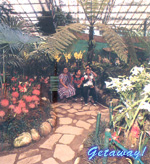 |
Do-Drul
Chorten ( Stupa) :
The
Do-Drul Chorten or Stupa was built by
the Venerable Trulshi Rimpoche,
head of the Nyingma order of Tibetan
Buddhism in 1945. Inside this stupa,
there are complete mandala sets of Dorjee
Phurba (Bajra Kilaya), a set of Kan-gyur
relics ( Holy Books), complete 'Zung'(
mantras) and other religious objects.
Around this Chorten, which is one of
the most important stupas in Sikkim,
are 10 Mani-Lhakor( prayer wheels).
These prayer wheels are turned by the
devout Buddhist while chanting "Hail
to the jewel in the Lotus", to
invoke the Buddhisattva. The Chorten
is surrounded by Chorten Lakhang, where
there are two huge statues of Guru Rimpoche
(Guru Padmasambhava).
|
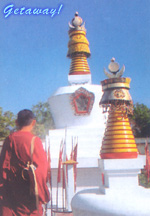 |
Handloom
and Handicrafts centre :
It is now known as the Directorate
of Handicrafts and Handlooms as well
as the Government Institute of Cottage
Industries. Started during the time
of the Chogyals of Sikkim, as a venture
to protect and propagate the craft and
skills of local and village artisans,
it has become on t of the major attractions
for people visiting Sikkim where traditional
handcrafts, furniture, handlooms carpets
and other products can be viewed and
also purchased . A word of caution to
the innocent guest. It is better to
check whether there is a government
holiday or not as the G.I.C.I. is closed
on Sundays, all government declared
holidays, second Saturdays and the odd
unforeseen holidays.
|
Sikkim
Research Institute of Tibetology(SRIT)
:
Formerly
known as the Namgyal institute of Tibetology,
after the late Chogyal of Sikkim, Palden
Thondup Namgyal whose brainchild it
was, the Sikkim Research Institute of
Technology(SRIT), has since become one
of the most prestigious depository of
Tibetan literature, rare manuscripts,
paintings, thangkas, statues and religious
objects and other works of art and history.
Today, it is a renowned worldwide centre
for study of Buddhist philosophy and
religion.
|
 |
Saramsa
Garden :
About
14 kms from Gangtok is the Saramsa Garden,
the home of Sikkim's most exotic orchids
and other rare tropical and temperate
plants. Established and maintained by
the Department of Forest, it is an excellent
recreation and picnic spot.
|
 |
Rumtek
Dharma Chakra Centre :
About
45 minutes drive from Gangtok, 24 kms
away, is the Rumtek Dharma Chakra Centre,
the seat of the Kagyu order, one of
the 4 major Tibetan Buddhist sects.
Since the late 1960s, after the arrival
of His Holiness the 16th Gyalwa Karmapa,
the Centre houses some of the world's
most unique religious scriptures and
religious rare objects. Traditional
in design, it is almost a replica of
the original Kagyurpa Monastery in Tsurphu,
Tibet.
|
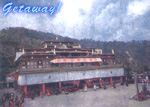 |
Jawaharlal
Nehru Botanical Garden :
Very
close by to Rumtek Monastery, and maintained
by the parks and Gardens unit of the
Forest Department of the Government
of Sikkim, the Garden is an enchanting
and soothing experience among the lush
green vegetation, rare plants and trees
and certain species of Himalayan flowers
and Orchids.
|
Water
Garden :
Water
Garden at Martam Khola is on the 31-A
National Highway some 16 kms. south
of Gangtok. It is an ideal spot for
picnic with a small swimming pool for
children.
|
Tsomgo Lake :
Tsomgo
lake is only 40 kms. from Gangtok town
and is situated at an altitude of 12,210
ft. The drive from Gangtok takes about
2½ hours by bus. The lake is
bout 1 km. long and oval in shape, 50ft.
deep and is regarded extremely Holy.
It is also a home of Brahmini ducks
besides stopover for various migratory
ducks.
|
 |
Between May and August, it is possible
to see variety of flowers in bloom, including
the rhododendrons, various species of
primulas, blue and yellow poppies, iris
and many other species of floras. It is
alson an ideal habitat of the Red Panda
and various species of birds. Open for
both the Foreign and Indian nationals.
Foreign visitors have to be in a group
of two or more and have to apply for the
visitors permit through a registered Travel
agency.
|
Nathula
:
56 kms from Gangtok is a 'Nathula' Pass
at an altitude of 14,200 ft. bordering
between India and China in the Tibetan
Plateau. It is one of the highest motorable
roads and richly covered by many varities
of alpine flora and fauna. A tranquil
place to visit. Nathula is open only
for Indian nationals on Wednesdays,
Thursdays, Saturdays and Sundays. The
visitors have to get the permit to visit
the place by applying to the Tourism
Department through a registered Travel
Agency.
|
Tashi
View Point :
Built
by the late King of Sikkim Sri. Tashi
Namgyal, it is situated 4 km from Gangtok
town from where one can have a clear
view of opposite hills, besides Mt.
Kanchandzonga. This site offers a breathtaking
panorama of the majestic Mt. Kanchandzonga
and surrounding hills.
|
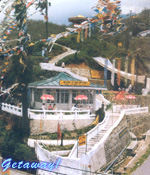 |
Ganesh
Tok :
It
is a very small temple of Ganesh, a
God worshipped by Hindus. It is on a
hillock on Gangtok-Nathula Road. A Sikkim
Government nursery is just nearby.
|
 |
Sa-Ngor-Chotshog
Centre :
It
is a Tibetan refugee monastic institution
established in 1961 by his Eminence
Luding Khen Rimpoche, Head of Ngorpa,
sub-sect of the Sakya Order, with the
blessing of H.H. Sakya Trizin and H.H.
the Dalai Lama. This is the only monastery
of the Sakya Order of Tibetan Buddhism
in Sikkim. It is located on a beautiful
hill-top just 5 kms away from Gangtok
Sikkim.
|
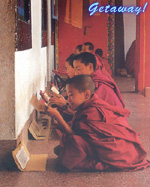 |
WEST
SIKKIM:
Pemayangtse Monastery:
Pemayangtse
Monastery is one of the oldest monasteries
in the State. Orginally established
by Lhatsun Chempo, one of the revered
Lamas to have performed the consecration
ceremony of the first Chogyal ( Religious
Monarch) of Sikkim. This ancient monastery
belongs to the Nyingma Buddhism and
has been considered as one of the premier
monasteries in the State, having been
entrusted with the task to perform all
religious functions of the erstwhile
monarch. The Monastery, located on a
hill top at an altitude of 6840 ft.
commands a magnificent panoramic view
of the Himalayan ranges and the surrounding
hills and country-side.
|
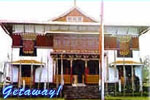 |
Rabdentse Ruins:
This
was the second capital of the erstwhile
Kingdom of Sikkim after Yuksom and till
the year 1814 AD, the Kings of Sikkim
had ruled the State from this place.
Today, the ruins lie hidden from the
main road at a walking distance from
the Pemayangtse Monastery. The scenic
view from the top of the ruins scanning
across the deep valley to the mystic
heights of Khangchendzonga ranges is
something to be cherished and etched
in memory.
|
 |
Sanga-Choling Monastery:
This
monastery is situated on a ridge above
Pelling and the famous Pemayangtse Monastery.
Built in 1697 AD, it is considered to
be the oldest monasteries in Sikkim.
In order to reach this Monastery one
has to be prepared to spend at least
40 nminutes walking up the steep hilly
slope which leads through rich forest
covers.
|
 |
Khecheopalri Lake:
Khecheopalri
Lake is considered to be one of the
sacred lakes of Sikkim both by the Buddhist
and the Hindus. The lake remains hidden
in the rich forest cover. It is believed
that birds do not permit even a single
leaf to float on the lake surface. There
is a motorable road from Pemayangtse
right up to the lake area.
|
For those interested in spending a night
or two in the peaceful environment a trekker's
hut has been provided by the Tourism Department.
The hut is presently managed by a local
person and provides comfortable stay providing
a taste of local Sikkimese -Nepalese cusines.There
is also a pilgrim's hut, managed by Tourism
Department, which is meant to provide
accomodation to the people who come on
pilgrimage tours.
|
Yuksam:
This was the first capital
of Sikkim, where according to the historical
records, the first Chogyal of the Kingdom
of Sikkim was consecrated in the 1641
AD by three learned lamas. The evidence
of the consecration ceremony is still
intact in Norbugang Chorten in the form
of stone seats and a foot print of the
Head Lama on the stone. Since the history
of
|
 |
Sikkim began from this place, these areas
are now considered sacred by the people
of Sikkim. Yuksam is served by all weather
road from Pemayangtse, which is at a distance
of 32 kms from Yuksam. The trek to Dzongri
and to the base camo of the famous Mt.
Khangchen-Dzonga begins here. |
Tashiding Monastery:
This
monastery is constructed on top of a
heart shaped hill with the back drop
of the sacred Mt. Khang-chen-Dzonga.
Acoording to Buddhist scriptures, Guru
Padma Sambhava (Guru Rimpoche) blessed
the sacred land of Sikkim in the 8th
century AD from the spot. The monastery,
however, was built
|
 |
in the 18th Century AD by Ngadak Sempa Chempo,
one of the three lamas who had performed
the consecration ceremony of the first Chogyal.
Tashiding is also famous for the most holy
chorten known as 'Thong-Wa-rang-Dol' which
literally means 'Saviours by mere sight'.
It is believed that the mere act of beholding
it is supposed to wash away all he sins
of the devotee. Another important feature
in tashiding is the sacred water festival
popularly knwon as 'Bhumchu'. It
is a religious tradition unique to Tashiding
Monastery only. Every year, on 14th and
15th day of the first Lunar Month, the Bhumchu
Ceremony is celebrated with devotees coming
from far and near to get the blessing of
the holy water. |
Varsey:
It
lies at an elevation of 10,000 ft. and
has a motorable road access upto Hilley.
An easy 4 kms trek from there takes
one up to the Varsey Rhododendron Sanctuary.
One can also trek from Soreng or Dentam
in West Sikkim. The place provides a
magnificent view of the mountains. Visitors
can halt at 'Guras Kunj' trekkers' hut.
|
Soreng:
Soreng
is a picturesque village with beautiful
landsacpe which is about 3 hrs. drive
from pelling and 4 hrs. drive from Melli.
A trek to Jhandi Danra from Soreng is
a must to see the various species of
flowers and birds. Hotels and lodges
are available for accomodation.
|
 |
NORTH
SIKKIM:
Phodong Monastery:
One
of the six major monasteries in Sikkim,
Phodong monastery is located in the
North approximately 38 kms from Gangtok,
4 kms beyond Phodong is the recently
renovated Labrang Monastery unique in
it architectural design.
|
 |
Phensang
Monastery:
This
monastery is situated on the gentle
slope stretching from Kabi to Phodong
with perhaps one of the best landscapes
in the region. The Phensang Monastery,
under the Nyingmapa Buddhist Order,
was built in 1721 during the time of
Jigme Pawo. It was gutted by fire in
1947 and rebuilt in 1948 hrough the
efforts of the lamas. The annual festival
of Chaam is performed on the 29th and
29th days of the tenth month of the
Lunar calendar (Tibetan Calendar).
|
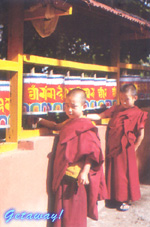 |
Singhik:
The
place offers one of the most spectacular
and closest views of Mt. Kanchenjunga
and its ranges. A well located Tourist
Lodge provides accomodation for visitors.
The area also has a number of interesting
short nature trails for 1 to 3 days
along the higher ridges of the higher
ridges of the surrounding hills. One
can also savour the most graceful peak
in the world, Mt. Siniolchu.
|
 |
Chungthang:
Chungtnahg,
on the confluence of Lachen and Lachung
Chu and the starting point of River
Teesta, has emerged as a major sub-division
settlement in North Sikkim. It is the
nodal junction for the two passes, Lachen
and Lachung. The valley is believed
to have been blessed by Guru Rimpoche
and one can visit the Holy Guru Lhedo
to see the foot and palm prints left
behind by the Patron Saint. The place
is rich in bio diversity with a large
variety of orchids, plants and wildlife,
is 95 kms from Gangtok, 23 kms from
Lachung, 29 kms from Lachen and is predominantly
a Lepcha region.
|
Lachung:
A
Bhutia village with a unique loacl self-governing
body called the Zumsa which substitutes
the Panchayat. Lachung has emerged as
a tourist destination with the soaring
popularity of Yumthang Valley which
is just 25 kms from Lachung. The village,
spreads out on either side of Lachung
Chu, has managed to retain its unique
culture and tradition. The Lachung Monsatery
on the slope opposite to the highway
is a focal point of all religious function
of the local inhabitants. To get a glimpse
of the religious functions performed
on auspicious occasion a visit to the
Monastery should form part of the tour
itinerary.
|
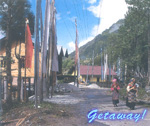 |
Yumthang:
Yumthang,
at an elevation of 11,800 ft and 140
kms from gangtok is a paradise for nature
lovers with a fascinating blend of flora
and fauna and breathtaking scenic granddeur.
The valley is also the home of Singbha
Rhododendron Sanctary with 24 species
of Rhododendrons. Yumthang 'Tsa-Chu'
or the hot spring of the left bank of
Lachung Chu is immensely popular for
its curative properties and healing
power.
|
 |
Lachen:
Lachen is situated at an altitude
of 2750 mtrs. and about 6 hrs. drive
from Gangtok. The Lachen Monastery Located
on top of the village commands a panoramic
view of the surrounding hills and country
side. Resorts, hotels and lodges are
available for accomodation.
|
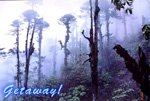 |
Guru-Dongmar Lake:
Guru-dongmar lake is considered
as one of the sacred lakes of this State
both by the Buddhist and the Hindus.
The lake remains milky in color throughout
and it is believed the Guru Padmasambhava
had touched the lake whilst he visited
Tibet from this area.
|
 |
SOUTH
SIKKIM:
Namchi :
Namchi,
meaning 'Sky High', nestled among the
hills at an elevation of 5,500 ft commands
panoramic view of the snow-capped mountains
and vast stretches of valley. Atop Samdruptse
hilltop near Namchi, recently erected
is the worlds tallest statue of Guru
Padmasambhava, the patron saint of both
Hindus and the Buddhist.
|
 |
Temi Tea Garden:
The
one and only tea garden existing in
the State produces one of the top quality
teas in the international market. The
tea garden is spread out on a gently
hill slope originating from the Tendong
Hill and provides a magnificent view
for the surrounding villages. The visit
to the factory could be an eye opener
for those wanting to know more about
tea processing methods.
|
Ravangla:
At
the base of Menam Hill is Ravangla,
a small township and transit to various
tourist destinations in South and West
Sikkim. It is also an upcoming tourist
spot, and transit point for trekkers
to Menam hill and Borong. There are
accomodation facilities and numerous
short nature trails. A trek down to
the sacred cave 'Sher Chok Bephu', one
of the four holiest caves in Sikkim,
would be a memorable experiance.
|
Menam Hill:
Menam Hill towers above Tendong Hill
on the other side over looking the ravangla
Bazar settlement. Situated at an altitude
of 10,300 ft the scenic view from this
height is, perhaps, unmatched in this
part of the world. Mt. Khangchendzonga
and its surrounding ranges looms above
the dwarf the richly forested and rugged
hill. On a clear sunny day, it is possible
to see the plains of Bengal spanning
across Kalimpong and darjeeling Hills
in the South, right across the Indo-China
border towards the North. A short distance
away is the legendary Bhaley Bhunga,
a kind of rocky spur which juts out
from the ridge top and remains suspended
in the air above Yangang village.
|
Borong:
Facing
the snow-capped mountains is Borong,
motorable from Ravangla or a trek via
Menam. A picturesque village, its beautiful
landscape and magnificent view is also
host to the hot spring, Borong TsaChu'.
The trek trail, originating from Namchi
or Damthang to Tendong - Ravangla -
Menam - Borong (5-6 days) is one of
the most interesting trails scaling
all the hill tops along the route. The
trek can continue to Tashiding or terminate
at Borong and drive back to Ravangla.
|
Contact us for
detailed Information: Inquiry/Booking
Form
Email: [email protected] |
|
| Sikkim
Places of Interest, Gangtok, Institute of Tibetology,
Rumtek Monastery, Tsomgo Lake, Nathula, Pemayangtse
Monastery, Kheocheopalri Lake, Yuksom, Singhik,
Chungthang, Lachung, Yumthang, Lachen, Guru
Dongmar Lake, Dzongri, Goechela Pass, Green
Lake, Tholung Gompa. |
|
|
Getaway!
Himalayan Eco-Trekking (P) Ltd
404 Sagarmatha
Complex, Naxal, Kathmandu.
G.P.O. Box 3606, Kathmandu, Nepal
Tel: (+977-1) 4431594, 4424921.
Fax: (+977-1) 4249986
Email:
[email protected] |
BIGFOOT
Treks & Adventures (P) Ltd
Sherpa Villa, Atisha Road
P.O. Kalimpong, 734301
Dist. Darjeeling, West Bengal
Tel: (+91) 3552 256685
Mobile: (+91) 98320 97425
Email: [email protected] |
|
|
|
























